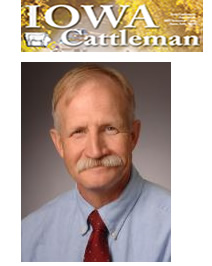Iowa Beef Center director column
August 2023
Reflections
Since this is my last column for the Iowa Cattlemen, this will be a reflection of the changes that have occurred in the cattle industry over the last 40 years. Much has changed since I came to Iowa in 1982.
Demographics. In 1982, the most cattle (700,000 head) were marketed by feedlots that marketed between 200 and 500 head per year. Diversified farming operations at the time often fed just one or two pens of cattle per year. Today over 400,000 head per year are marketed by feedlots that feed 5,000 head or more annually. Iowa still markets more cattle from under 1,000-head feedlots than any other state, but generally feedlots have become larger and more specialized. In a CattleFax study funded by the ICA in 1984 it was found that only 25% of Iowa feeders had record systems that would allow them to calculate feed efficiency or cost of gain on a pen of steers. Today virtually all feedlots have incorporated performance tracking systems. Over the last 40 years the number of beef cow operations has been reduced by about half. That is consistent with the reduction in the number of farms in general. Beef cow numbers have decreased consistent with the decrease in the national herd.
Technology. The development of the internet and communications technology was perhaps the most impactful technology over this time. Additionally new combination implants, feed additives including beta agonist and new generation antibiotics impacted the feedlot industry. For cow-calf operations, improved estrus synchronization and timed artificial insemination protocols, and the development of genomic tools have improved cattle selection. Improved fencing technologies have allowed adoption of controlled and rotational grazing.
Feed resources. Today, Iowa has less than half of the pasture acres that existed in 1982. Much of the reduction is in cropland pasture that may have been part of a rotation. Today much of the land formerly used for cropland pasture is in a corn-bean rotation or in CRP. The rapid growth of the ethanol industry in Iowa in the early 2000s brought distillers grains as a common, high quality, competitively priced energy and protein source for cattle. This was a major factor in improving the competitiveness of cattle feeding in the upper Midwest.
Changing cattle. In 1991 the beef industry declared a war on fat to meet the demands of consumers looking to reduce fat and cholesterol in their diet. The result was a reduction in quality grade and an increase in undesirable eating experiences. In response, the industry worked on improving beef quality in the early 21st century. Aided by the development and improvement of carcass ultrasound technology and the use of marbling EPDs, beef quality has been in steady improvement since then. Through all of this, carcass weights have been increasing 4-5 pounds each year. Today’s beef steer is much bigger than it was 40 years ago.
So, what does the future look like? Like my economist and meteorologist friends, I am much better at predicting the past than the future. Precision livestock technology is poised to make major impacts in improving decision making in the future. Consumer demands will continue to evolve, and we will need to respond accordingly. And environmental sustainability and animal care and welfare will continue to have major importance into the future.
As of this writing, dry conditions exist in many parts of Iowa. Look for our team to offer local educational programming in response to drought as needed. Also look for BQA certification programs in your area.
The IBC at Iowa State University serves as the university’s extension program to cattle producers. Our center comprises a team of faculty and staff from the College of Agriculture and Life Sciences, the College of Veterinary Medicine and Iowa State University Extension and Outreach. We work together to develop and deliver the latest in research-based information to improve the profitability and vitality of Iowa’s beef industry. If you’d like to be notified of updates on progress of research projects or programs that might be coming to your area, please subscribe to our “Growing Beef” newsletter by following the link on our website, www.iowabeefcenter.org. If you have a question, use our “Ask our Experts” link. Also, feel free to call us at 515-294-BEEF or email us at beefcenter@iastate.edu. You can follow @iowabeefcenter on Facebook, Twitter, YouTube and Instagram.

